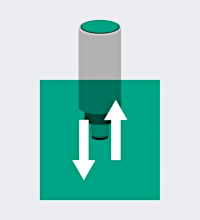Communication Interfaces

To connect inductive sensors, IO-Link or AS-Interface are often used as digital communication interfaces. Various other bus systems (e.g., PROFIBUS, DeviceNet, MODBUS) are available in the field of industrial sensor technology.
IO-Link
IO-Link is a point-to-point communication system. Sensors with IO-Link (these can be photoelectric sensors, inductive sensors, ultrasonic sensors, etc.) are backward compatible with binary sensors with a switching output. If an IO-Link master is not connected to the sensor, the sensor operates in SIO operating mode (SIO = standard input and output) with a conventional switching output. Integrating an IO-Link sensor into existing systems is thus possible with no restrictions. If the sensor detects a connected IO-Link master when it is switched on, it operates in IO-Link communication mode. In communication mode, the full range of functions of this interface technology is available:
- Parameterization of sensor functions
- Reading out of process data
- Transfer of diagnostic data
The use of IO-Link also offers the following advantages:
- Reduction in the number of versions—one IO-Link sensor replaces multiple sensors with different output stages
- Reduction in machine downtime due to differentiated diagnosis
- Availability of diagnosis information during ongoing operation for preventative servicing
- Reduction in project planning and installation costs due to standardized interface
- Simple three-core cable to connect all sensors
- Combined use of different sensor types: the IO-Link master enables the connection of different sensor types—even the connection of simple binary sensors
Note on Installation
Always install sensors with a three-core cable to the IO-Link master.
Background
Sensors on connection pins 3 or 5 often provide additional functions. When a sensor with a four-core or five-core cable is connected to a master with a Class B port, this can result in the following effect: The galvanically isolated additional supply of the Class B port (pins 3 and 5) is coupled with the standard IO-Link cables via such additional lines. This may affect the function of the sensor. In a worst-case scenario, this may damage the sensor.
Fieldbus Systems in Factory Automation
Sensors with appropriate bus interfaces can use a joint transmission path for communication between several nodes in the network of a production plant. The kind of bus system used is largely determined by which programmable logic controller is used.
Typical bus systems are:
AS-Interface
The actuator-sensor interface (AS-Interface) replaces conventional wiring technology at sensor-actuator level. AS-Interface has firmly established itself as a global standard for cost-effective signal transmission on a single line for energy and signals. It is an open system and therefore found below all common fieldbus systems.
PROFIBUS
PROFIBUS is a standard for fieldbus communication and is used in automation and manufacturing engineering. PROFIBUS is available in several versions, with PROFIBUS DP being the version used for manufacturing engineering. The offers the particular benefit of providing fast communication between control panels and sensors/actuators in machinery and plants. PROFIBUS is standardized in the IEC 61158 standard.
DeviceNET/ControlNet
DeviceNET is an open fieldbus standard based on the CAN protocol. ControlNET is a network protocol developed for industrial automation applications. The advantages lie in the redundant cabling and the fact that communication can be clearly terminated and highly deterministic. Both fieldbuses use the Common Industrial Protocol (CIP) as a common application layer and can therefore easily be used with EtherNet/IP.
CC-Link
CC-Links are open, industrial networks used for control and for information transmission. The fieldbus solution has a high transfer speed and deterministic communication. CC-Link can be used for machine control and for controlling processes, factory equipment, and building automation.
MODBUS
MODBUS is an established open requester-responder or client-server protocol. MODBUS can be used either with serial interfaces or with Ethernet. Various operating modes are available for data transfer: TCP, RTU, and ASCII. MODBUS is frequently used in factory automation.
CANopen
CANopen is a CAN-based protocol that transfers data particularly quickly. CANopen is used in automation technology, drive technology, and for networking complex devices. CANopen is standardized in the European standard EN 50325-4.
INTERBUS
INTERBUS is a universal fieldbus system. It is used in many different application areas such as at the sensor/actuator level and in process automation. INTERBUS is particularly popular in the automotive industry.
Sercos
Sercos is an automation bus that functions as a standardized open digital interface for high-speed, real-time communication. Sercos can be used to communicate between industrial control panels, peripherals, and standard Ethernet network nodes.









 +49 621 776-0
+49 621 776-0